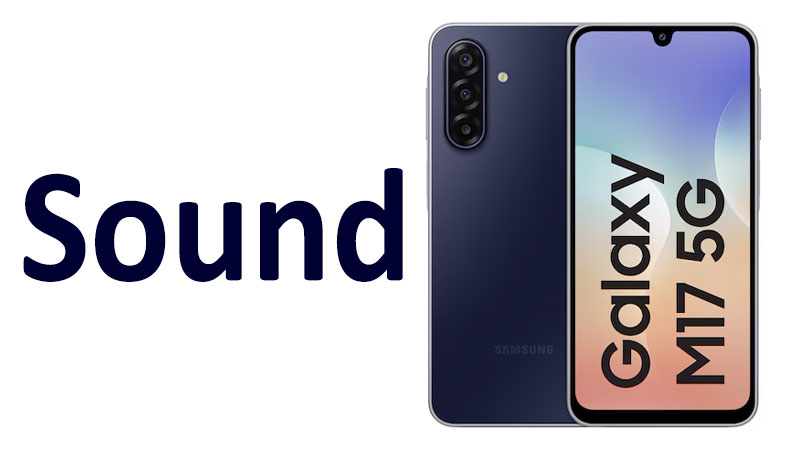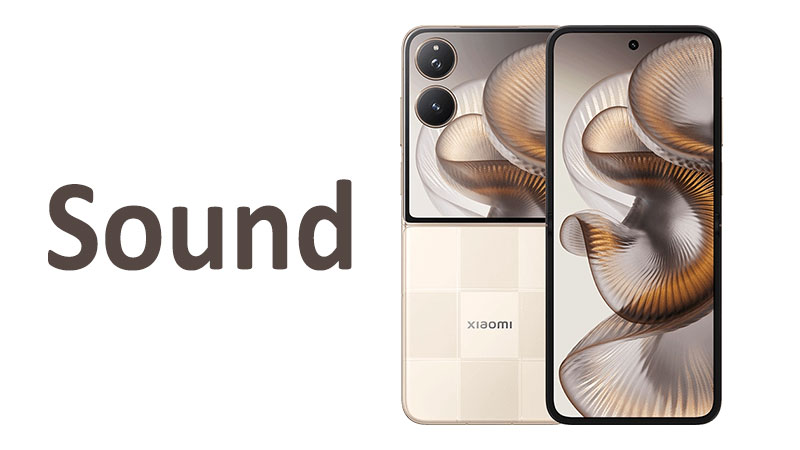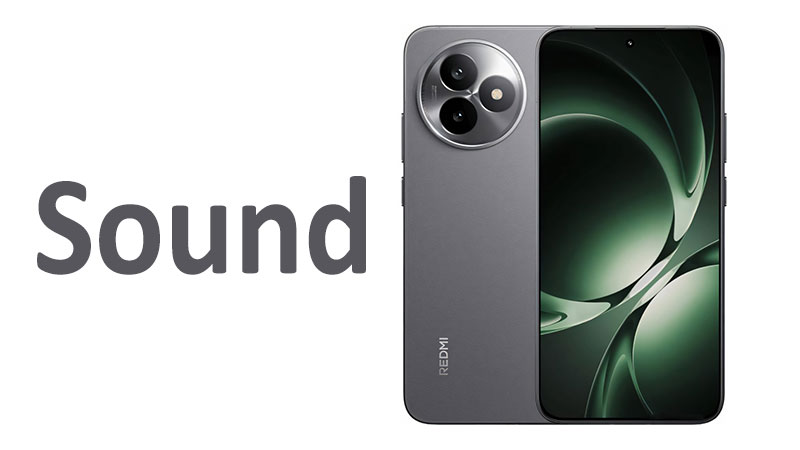The Samsung Galaxy M17 Sound experience is a key feature for this value-focused smartphone. Audio quality holds high importance for modern consumers. Users expect loud, clear built-in speakers for all their daily media consumption. Furthermore, reliable support for external headphones is absolutely essential. This detailed review explores every key aspect of the Samsung Galaxy M17’s sound system meticulously. We will examine the specific hardware configuration and the specialized software processing involved. Understanding these elements is crucial for maximizing the device’s strong multimedia potential effectively. This analysis helps potential buyers decide if the sound profile meets their specific listening needs.
Acoustic Hardware and Speaker Design Analysis
The Samsung Galaxy M17 employs an acoustic setup typical of the performance-oriented M-series. This configuration is designed for maximum functional output and longevity. The phone’s design often features a robust, slightly thicker chassis. This increased size, driven by a large battery, can potentially benefit the internal acoustics. Samsung engineers optimize the speaker system for clarity and efficiency under budget constraints. Understanding the hardware shows the realistic capabilities of the phone’s sound delivery system.
Speaker System Overview: Functional Mono Design
The Galaxy M17 typically utilizes a single, down-firing mono speaker. This configuration is very common across budget and mid-range Samsung devices. The single speaker is strategically placed on the device’s bottom edge. This directs sound outwards when the phone sits vertically or in a stand. This placement, however, requires careful handling during horizontal video viewing. Users must avoid inadvertently covering the speaker grille with their hand. While this mono setup delivers sufficient loudness, it fundamentally lacks true stereo sound immersion.
Driver Technology and Chamber Potential
The single speaker driver is engineered primarily for power and long-term efficiency. It uses standard driver materials optimized for cost and reliable performance. The M-series phones are generally known for larger battery compartments. This sometimes allows for a marginally larger internal speaker chamber size. A slightly larger chamber can potentially offer a touch more resonance than extremely thin devices. The phone relies on an integrated Power Amplifier (PA) chip. This essential component manages the speaker’s power output carefully. It helps to suppress common distortion effectively at moderate listening volumes.
Design and the Megabattery Factor
The M-series design heavily emphasizes battery capacity, often resulting in a thicker profile. This megabattery factor is a key consideration for audio design. Thicker chassis often provide better dampening and less vibration transfer. This beneficial structural stability can slightly improve sound clarity compared to ultra-slim competitors. Buyers should know the design focuses on loud, functional audio rather than complex spatial sound. The single speaker placement is an engineered compromise for device longevity and internal component layout.
Specialized Comparison: M17 Speakers vs. M16/A17
The Galaxy M17’s speaker setup generally mirrors the functional mono design of its predecessor, the Galaxy M16. However, the internal chamber design might be slightly refined for improved efficiency. Compared to its close cousin, the Galaxy A17, the speaker configuration is fundamentally the same: mono. Where the M17 might edge out in perception is due to its potentially more stable, thicker chassis. This extra material can sometimes minimize external resonance compared to the A-series phones. Ultimately, both devices prioritize software enhancements like Dolby Atmos over raw speaker hardware.
Acoustic Performance and Sound Signature Breakdown
A thorough sound quality review must examine the M17’s specific frequency performance profile. As a value-centric phone, the M17 targets clear, reliable sound for everyday tasks. The audio signature is intelligently tuned for excellent clarity, especially in the human voice frequency range. This tuning makes the device highly suitable for calls, podcasts, and streaming general media content.
Frequency Response Breakdown: Bass Performance
The bass response from the single speaker is primarily modest and purely functional. Low-end frequencies lack the significant depth or resonant impact of a dedicated woofer. Sub-bass is typically not well-reproduced by the small driver unit. The speaker focuses on the upper-bass and lower-mid frequencies for necessary warmth. This tuning avoids pushing the small driver into severe audible distortion. Listeners should set their expectations: this phone does not deliver punchy or deep impactful bass. However, it provides enough low-end grounding for most casual pop music listening sessions.
Frequency Response Breakdown: Midrange Clarity
The midrange is undeniably the strongest and most articulate area of the M17’s sound profile. This tuning is highly strategic for a phone targeting maximum utility. Vocals, dialogue, and general phone conversations are reproduced with excellent clarity. The sound ensures superb intelligibility for all forms of spoken content effectively. Essential instrumental sounds like horns and guitars are handled cleanly and are easily distinguishable. This strong midrange performance makes the phone truly excellent for listening to audiobooks, podcasts, and news broadcasts.
Frequency Response Breakdown: Treble Response
The treble response is generally clean, crisp, and well-managed for the price range. High-frequency elements, such as cymbals and effects, are clearly audible without sounding harsh. Samsung tunes the upper frequencies to provide brightness without becoming fatiguing or sibilant. The sound avoids the annoying metallic or tinny quality found in lesser budget speakers. Overall, the treble is balanced just enough to deliver necessary detail. It helps distinguish audio layers without causing discomfort during extended listening periods.
Loudness, Distortion, and Clarity Metrics
The Galaxy M17 achieves a very competitive maximum loudness level for its segment. It is easily loud enough for simple indoor listening or for use in a moderately noisy environment. Distortion control is reasonable, but it becomes noticeable above approximately 85% of the maximum volume. This minor limitation is inherent to all entry-level driver and PA systems. For the absolute clearest audio, users should keep the volume slightly below the peak setting. The overall clarity remains highly acceptable up to that 85% threshold effectively.
Soundstage and Immersion Quality
The experience of soundstage is inherently limited due to the single-speaker mono output. The internal speaker cannot create any true stereo separation or spatial sound effect. All audio elements originate from the centralized point on the bottom edge. This significantly reduces the sense of immersion when consuming gaming or cinematic media. For any truly immersive audio, external headphones remain the best and only solution. The internal mono speaker is best viewed as a basic, loud, and highly functional communication tool.
Wired and Wireless Audio Connectivity Features
The Samsung Galaxy M17 offers key connectivity features for all external audio accessories. These essential features are highly valued by users looking for versatility and convenience. Users need flexible options for connecting their various headphones and speaker setups easily. The phone supports necessary formats across both its wired and all wireless connections.
The Essential 3.5mm Headphone Jack
The Samsung Galaxy M17 makes a crucial decision by retaining the traditional 3.5mm headphone jack. This inclusion is a significant selling point in the value smartphone segment. It allows users to connect their cherished wired headphones directly without any external adapter. The integrated analog output is managed by a standard internal audio codec chip. This chip effectively handles the Digital-to-Analog Conversion for all wired listening. The resulting output power is generally sufficient for most consumer earbuds and low-impedance headphones.
Digital Audio Output via USB-C Port
The device also reliably supports digital audio output through its main USB-C port. This feature is becoming increasingly useful for owners of USB-C headphones or portable Digital-to-Analog Converters (DACs). The phone can output a clean, unprocessed digital audio stream to these external components. This configuration allows the external device to manage the higher-quality audio conversion process. Digital output reliably supports basic audio formats, generally up to 16-bit/48kHz resolution.
Standard Bluetooth Codec Support
For completely wireless listening, the Galaxy M17 provides reliable support for all essential Bluetooth codecs. It supports core industry standards such as SBC and AAC consistently. AAC (Advanced Audio Coding) delivers a superior listening experience compared to the basic SBC codec on compatible hardware. This level of support is perfectly adequate for the majority of mainstream wireless earbuds and headphones. It provides a decent quality listening experience for most common music streaming services. However, the M17 usually omits support for premium, high-resolution codecs like LDAC or aptX HD/Adaptive. This is a common and understandable limitation for a budget-focused device.
Specialized Comparison: M-Series Connectivity Focus
The M17’s inclusion of the 3.5mm jack provides a major competitive edge over many competitors. Many budget phones are now choosing to remove this highly useful feature. The M17 offers simultaneous compatibility through both the analog jack and the modern USB-C digital output. The audio output quality via the jack is surprisingly clean and consistent for this price category. While its wireless codec support is entirely basic (AAC), this is functionally adequate for the majority of mobile users. The Galaxy M17 successfully prioritizes highly practical, versatile, and accessible connectivity options for everyone.
Software Optimization and Audio Features
The audio hardware of the Samsung Galaxy M17 is significantly augmented by specialized software optimization. These critical features are tightly integrated directly into Samsung’s customized One UI operating system. The software includes several key audio-specific enhancements for the user experience. These features are specifically designed to customize and dramatically improve the overall headphone listening quality. This software layer is absolutely vital for maximizing the full potential of the wired and wireless output.
Dolby Atmos Surround Enhancement
The most powerful software feature is the inclusion of Dolby Atmos sound enhancement technology. While this feature offers little benefit to the internal mono speaker, it is incredibly transformative for headphone use. Dolby Atmos actively creates a highly immersive, three-dimensional sound field when activated. This advanced technology successfully adds a crucial sense of height, depth, and width to the audio mix. This greatly enhances the sense of realism during mobile gaming sessions and cinematic viewing. Users must connect headphones or earbuds to fully activate and experience this enhancement effectively. This feature represents a major, unexpected value-add for all budget audiophiles.
Customization and Equalization Tools
The phone includes robust and exceptionally user-friendly tools for personalized audio tuning. Users can easily access detailed audio settings directly within the standard One UI system menu. A full multi-band graphic equalizer is provided for precise fine-tuning of the sound signature. This allows advanced users to tailor the sound precisely to their favorite genres or listening preferences. Presets optimized for various music genres, such as Pop, Rock, and Classical, are also readily available. Furthermore, Samsung often includes its unique “Adapt Sound” feature. This tool successfully creates personalized sound profiles based on the user’s specific age and unique hearing sensitivity.
Microphone and Recording Quality
The Samsung Galaxy M17 features a functional multi-microphone array for effective communication. This array is designed for achieving clear voice capture during calls and basic video recording. Software processing includes essential environmental noise reduction (ENR) technology. This critical system intelligently filters out common, disruptive background noise during phone conversations. This helps to ensure that the user’s voice remains consistently clear and fully intelligible for the person on the other end. The resulting recording quality is entirely suitable for quick voice notes and casual video recording needs.
Specialized Comparison: Software Ecosystem Advantage
The inclusion of the full Dolby Atmos suite is a major software advantage for the Galaxy M17. Many direct budget competitors typically omit this powerful, licensed feature entirely. This single feature alone drastically improves the quality of the headphone experience for music and movies. Samsung’s full-featured graphic equalizer and the unique Adapt Sound tool also stand out as strong customization benefits. These specific tuning options are often more granular and intuitive than those found on rival budget devices. The M17 effectively utilizes its deep software stack to provide a much richer audio experience than its basic speaker hardware initially suggests.
Buyer’s Guide: Pros, Cons, and Key Considerations
The overall audio experience of the Samsung Galaxy M17 is practical and highly competitive for its budget segment. It strongly appeals to users who prioritize essential features, battery life, and headphone connectivity. Potential buyers must carefully weigh the sound system’s strengths against its few necessary limitations. This balanced and comprehensive assessment ensures an informed and completely confident purchase decision overall.
Pros of the Audio System
The benefits of the Samsung Galaxy M17’s functional audio setup are clear and compelling.
- Dedicated Headphone Jack: The 3.5mm jack provides crucial compatibility and user choice instantly.
- Dolby Atmos Integration: This specialized software feature dramatically enhances headphone listening quality.
- Excellent Midrange Clarity: The internal speaker is well-tuned for clear calls and crucial dialogue consumption.
- Comprehensive Customization: The full graphic equalizer and Adapt Sound feature allow detailed user tuning.
- Functional Speaker Loudness: The mono speaker is loud enough for most basic, daily listening scenarios effectively.
- Solid Chassis Dampening: The thicker M-series body potentially offers better stability than many thinner phones.
Cons of the Audio System
While the system is impressive for the price, it does have a few predictable limitations typical of a budget device.
- Mono Speaker: The single speaker fundamentally limits audio immersion and stereo separation effects.
- Bass Deficiency: The small internal driver prevents deep, impactful low-frequency performance entirely.
- Limited Wireless Codecs: The phone lacks support for advanced high-resolution codecs like LDAC or aptX HD.
- Distortion at Max Volume: Sound integrity noticeably degrades when the volume is pushed past the 85% mark.
- Placement Issue: The single bottom-firing speaker is easily covered by a user’s hand during gameplay.
Important Points a Buyer Should Know
A reader considering the Samsung Galaxy M17 must fully understand its detailed audio characteristics. This crucial understanding helps to set realistic expectations for the device’s sonic capabilities effectively.
First, utilize the 3.5mm headphone jack. This included feature is a major benefit for anyone owning quality wired headphones. It immediately removes the need for easily misplaced USB-C adapters.
Second, always ensure you activate Dolby Atmos with your headphones. This setting is the single greatest audio quality improvement available on the device. Remember to manually enable it within the phone’s sound settings menu.
Third, manage your speaker expectations carefully. The mono speaker is best reserved for quick calls, alerts, and consuming podcasts. For listening to music or movies, using headphones is strongly recommended for a satisfying experience.
Fourth, keep the volume moderated consistently. To maintain the best possible clarity and avoid noticeable distortion, keep the internal speaker volume reliably around the 75% to 80% maximum level.
Finally, appreciate the robust software. The phone offers a level of audio customization (Equalizer, Adapt Sound) often missing in rival budget phones. Make sure to personalize these settings.
Conclusion
The Samsung Galaxy M17 Sound system ultimately delivers a highly capable and entirely satisfying auditory experience for its specific price point. The phone successfully provides essential features that value-conscious users need and highly appreciate. The practical combination of a loud, functional mono speaker and the much-welcomed 3.5mm headphone jack is a pragmatic choice. The phone’s true audio strength is definitively rooted in the sophisticated software side of the equation. Specifically, the strong inclusion of Dolby Atmos and the personalized Adapt Sound features drastically enhance the external headphone listening quality. While the internal speaker is mainly functional and mono, the overall external audio experience is surprisingly robust and richly customizable. The Samsung Galaxy M17 is an excellent choice for users prioritizing an affordable phone with versatile connectivity. Its strong commitment to advanced software enhancement makes it a remarkably sound choice among all budget-friendly smartphones.
Frequently Asked Questions (FAQ)
1. Does the Samsung Galaxy M17 include a 3.5mm headphone jack?
Yes, the Samsung Galaxy M17 includes the traditional 3.5mm headphone jack for wired audio accessory use.
2. Is the internal speaker on the Galaxy M17 stereo or mono?
The internal setup features a single, down-firing mono speaker, which is a common characteristic in this price range.
3. Does the Galaxy M17 support Dolby Atmos?
Yes, it supports Dolby Atmos, but the effect is primarily functional and noticeable when using external headphones or earbuds.
4. What high-resolution Bluetooth codecs does the M17 support?
The M17 typically supports standard codecs like SBC and AAC but generally lacks advanced codecs like LDAC or aptX HD.
5. Can the audio output be customized for individual hearing?
Yes, the phone includes Samsung’s “Adapt Sound” tool for creating personalized sound profiles tailored to the user’s specific hearing.



